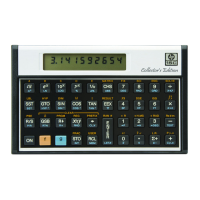ii Introduction
In RPN, the solution is to begin at the innermost set of two numbers and
proceed outward. The solution 4 v 3 + 2 v 1 + ÷ displays
the answer of 2.3333 using 9 keystrokes. Competing calculators of its day
and even for several years afterward that did not use RPN could not solve this
problem readily without a lot of parentheses. In RPN, all problems are solved
with the same approach. If you are not familiar with RPN already, time spent
with that portion of this HP 15c CE manual will pay many benefits in the
future.
HP continued to introduce more capable and updated scientific models over
the next few years, such as the HP-45 introduced on May 1, 1973, which
added some statistical functions, conversions and multiple angular modes
for trigonometry, followed by the HP-21, introduced on February 1, 1975,
which provided the same capabilities as the HP-35 in a smaller-sized
calculator at one third the cost, a mere three years after the debut of the HP-
35.
HP also introduced a range of business models, such as the HP-80, the HP-
70, and the HP-22. These models revolutionized financial and business
calculations as much as their scientific models changed the world for
scientific and technical users, since it was now possible to solve problems
such as ones involving the time value of money on a handheld calculator.
Another revolutionary device developed by HP was the HP-65 fully
programmable pocket calculator, introduced on
January 19, 1974. Known internally at HP by the code
name “Superstar”, it was truly a game changer. The HP-
65 featured a large number of scientific functions, but
also provided users with the option to write programs
to solve new problems and add new functions to the
machine, which could be recorded and saved on
magnetic cards, so that the calculator and also your
cards with programs and data recorded on them could
all be carried with you and could even fit in a large
pocket. The 100-step program memory was huge for
the time and, even then, program execution could be
extended by reading successive program cards into the
calculator for further processing. HP-65 users were
able to submit programs they had created to the HP-65
Users’ Library where they could be shared with other users. Well over 5500
programs were submitted to the library and made available to its members
for a nominal fee. In addition, a large number of books were written, some
about techniques to use on various calculator models, but others focused on
HP-65

